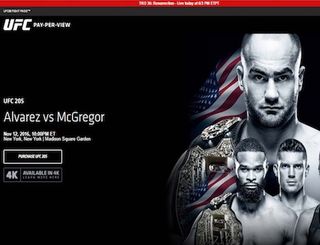UFC Gets 4K Live-Streaming Treatment

Last April, the state of New York ended its ban on mixed martial arts, paving the way for its first-ever UFC event, the Nov. 12 UFC 205, with ringside seats selling for around $8,000 on the secondary market in the days leading up to it.
Knowing that only about 18,000 spectators can fit into Madison Square Garden, UFC made a big deal out of its $60 pay-per-view offering, giving fans a first-time 4K live-streaming option, available everywhere in the world but China.
But there were plenty of challenges in putting together a 4K live stream, according to Chris Wagner, senior VP of online video technology company NeuLion, which handled all the back-end work for the stream, as well as the app consumers needed in order to watch it.
Wagner spoke with Next TV before UFC 205 about the technology behind the 4K stream, persistent bandwidth issues and how to get around them and the future of 4K streaming. An edited transcript follows.
NTV: What are some of the technical challenges behind doing this?
Chris Wagner: We’d been working on it for over a year, with a bunch of trials, some with the NBA, a big event with Univision. We’ve been working on our software encoder, which fits inside 4K truck productions, and we’re not using HTTP Live Streaming (HLS), Apple’s video format, we’re using High Efficiency Video Coding (HEVC), a higher-video compression codec we’ve tweaked to deliver a high-quality, no-drop 60 fps [frames per second]. In addition to the video workflow for 4K, we have a billing engine that lets you sell a digital ticket, which is what UFC did, for $59.99. We streamed in both HD and 4K live, depending on the device.
We also built them an OTT monitor, where in real time they could see globally who was watching, what device they were on and what the average bit rate and buffering was. All the analytics from our live stream ran on this dashboard. Then we had a UFC 4K app, available in the Google Play store, so owners of Sony UHD TVs could install it and use their digital ticket there.
NTV: What is it going to take to move beyond just Sony for 4K?
Wagner: We have agreements in place with Samsung and LG for our SDK; it’s just that Sony was the first to roll it out. Others have licensed our technology and will roll it out soon.
Broadcasting & Cable Newsletter
The smarter way to stay on top of broadcasting and cable industry. Sign up below
NTV: U.S. bandwidth speeds aren’t exactly on top of the world. Are there any concerns when you talk about streaming things such as 4K, HDR and higher frame rates?
Wagner: On the July 9 test we did for another UFC event, the average viewer on Sony averaged 18 Mbps. The stream is adaptive. If your bit rates drop below 18, it moves to an HD 720p feed. It’s not fixed, and adapts to whatever your internet connection is. There are countries that don’t have great bandwidth, but in the U.S., Western Europe and parts of Asia, broadband is plentiful.
NTV: For sports it’s become a game of whack-a-mole trying to shut down illegal streams. What are the concerns?
Wagner: It is a tough problem. For a PPV event that costs $60, video quality is part of the attraction. You won’t be able to pirate that quality by pointing a camera at the TV. The video quality suffers in illegal streaming. If you’re a big UFC fan, you’re going to pay the $60 to watch it in 4K. UFC has a service that focuses on pirated streams, and they’ve been pretty successful at shutting them down.
NTV: And why not China? What’s it going to take to get over there?
Wagner: We have a deal with Hisense, which licensed our 4K SDK; they just haven’t rolled it out yet. Broadband in China is more difficult, and it’s difficult to go over-the-top there. 4K isn’t going to happen on a cable set-top box. It’s going to be all internet-delivered. We expect to get there later.
